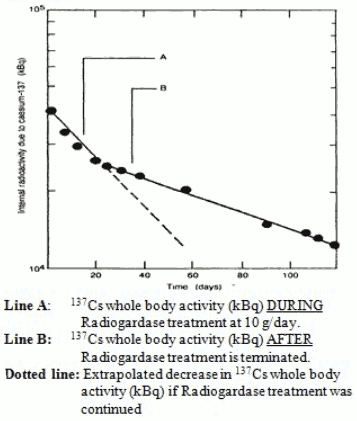Prussian blue
Chemical formula: C₁₈Fe₇N₁₈ Molecular mass: 859.239 g/mol PubChem compound: 2724251
Mechanism of action
Prussian blue insoluble, ferric hexacyanoferrate(II), acts by ion-exchange, adsorption, and mechanical trapping within the crystal structure, and has a high affinity for radioactive and non-radioactive cesium and thallium.
Prussian blue insoluble binds cesium and thallium isotopes in the gastrointestinal tract after these isotopes are ingested or excreted in the bile by the liver, thereby reducing gastrointestinal reabsorption (enterohepatic circulation). The rate of cesium and thallium elimination is proportional to the duration and dose of prussian blue insoluble.
Pharmacodynamic properties
Cesium-137 (137Cs)
137Cs has a physical half-life of 30 years, with a beta energy peak at 174.0 keV. Following entry into the blood, it is distributed uniformly through all body tissues. Approximately 10% of 137Cs is eliminated rapidly with a biological half-life of 2 days; 90% is eliminated more slowly, with a biological half-life of 110 days; and less than 1% of the 137Cs is retained with a biological half-life of about 500 days. 137Cs follows the movement of potassium and is excreted into the intestine, reabsorbed from the gastrointestinal (GI) tract into the blood, then to the bile, where it is excreted again into the GI tract by bile via enterohepatic circulation. Without prussian blue treatment, about 80% of 137Cs is excreted through the kidneys and about 20% in the feces.
Thallium-201 (201Tl)
Radioactive thallium (201Tl) has a physical half-life of 3 days with electron and photon emissions with a gamma energy peak at 167.4 keV. Non-radioactive thallium has a biological half-life of 8–10 days.The physiologic transport of thallium follows the same route as potasium and is excreted by bile in enterohepatic circulation. Without prussian blue treatment, the fecal to urine excretion ratio of thallium is approximately 2:1.
The results of fecal analysis from patients contaminated with 137Cs and treated with prussian blue showed higher activities of 137Cs in feces, and the associated whole body radioactivity counts showed a more rapid rate of elimination from the body. The effectiveness of prussian blue for one patient is shown in Figure 1. The whole body content of radioactive material of 137Cs in kilo-Bequerels (kBq) is shown on the y-axis. Time in days is on the x-axis. Line "A" represents the whole body activity of 137Cs during prussian blue insoluble treatment at 10 g/day. The dotted line represents extrapolation of the whole body activity if treatment was continued. Line "B" represents the whole body activity of 137Cs, after prussian blue insoluble was stopped.
Figure 1. Comparisons of 137Cs whole body activity during and after prussian blue treatment:
Pharmacokinetic properties
Absorption/Elimination
Prussian blue insoluble is not absorbed through the intact gastrointestinal wall. Its clearance from the body depends on the gastrointestinal tract transit time.
Food Effects
Food effect studies have not been conducted. In animal studies, Prussian blue insoluble was not significantly absorbed. Food may increase the effectiveness of prussian blue insoluble by stimulating bile secretion.
Preclinical safety data
Absorption/Elimination
In an animal study (pigs, n=38), after a single dose of 40 mg of labeled prussian blue insoluble, 99% of the administered prussian blue dose was excreted unchanged in feces. Absorption from multiple doses has not been studied.
In a study using rats (n=40, mean body weight range of 188–219 grams) injected with 137Cs, a dose response relationship was demonstrated for the amount of radiation elimination with prussian blue insoluble at doses of 1 to 50 mg/day (Table 1). There is little difference in radiation elimination rate between prussian blue insoluble at doses of 50 to 100 mg/day. In Table 1, the % of Injected Radiation Dose Remaining is defined as the percentage of the total injected dose of 137Cs remaining in the body at 96 hours post administration.
Table 1. Dose Response Relationship in Rats at 96 Hours:
| Prussian blue insoluble dose (mg/day) | % Injected 137Cs dose remaining (Range) |
|---|---|
| Untreated | 58.1 (63.3–53.4) |
| 1 | 9.42 (13.2–6.72) |
| 10 | 1.17 (1.64–0.84) |
| 50 | 0.57 (0.80–0.41) |
| 100 | 0.52 (0.73–0.37) |
In studies of rats, pigs, and dogs that were internally contaminated with cesium and thallium, the presence of the insoluble complexes in the gastrointestinal lumen changed the primary elimination route from the kidney to the feces and increased the rate of elimination of these two contaminants.
Related medicines
© All content on this website, including data entry, data processing, decision support tools, "RxReasoner" logo and graphics, is the intellectual property of RxReasoner and is protected by copyright laws. Unauthorized reproduction or distribution of any part of this content without explicit written permission from RxReasoner is strictly prohibited. Any third-party content used on this site is acknowledged and utilized under fair use principles.
